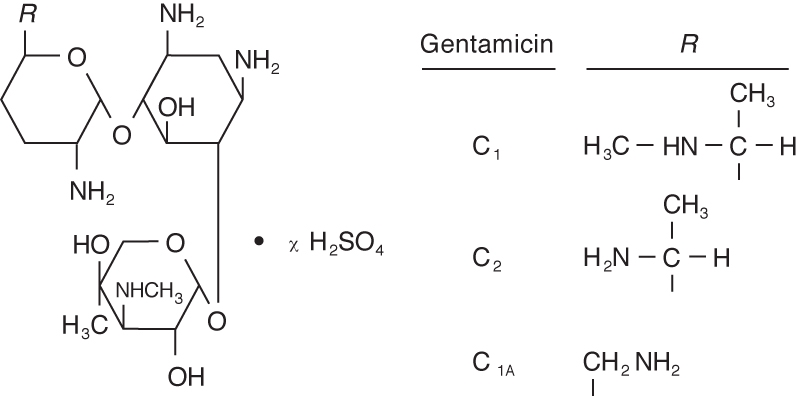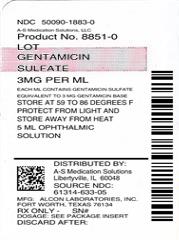GENTAMICIN SULFATE solution
Gentamicin Sulfate by
Drug Labeling and Warnings
Gentamicin Sulfate by is a Prescription medication manufactured, distributed, or labeled by A-S Medication Solutions. Drug facts, warnings, and ingredients follow.
Drug Details [pdf]
-
DESCRIPTION
Gentamicin Sulfate is a water-soluble antibiotic of the aminoglycoside group. Gentamicin Sulfate Ophthalmic Solution is a sterile, aqueous solution buffered to approximately pH 7 for ophthalmic use. Gentamicin is obtained from cultures of Micromonosporapurpurea. It is a mixture of the sulfate salts of gentamicin C1, C2, and C1A. All three components appear to have similar antimicrobial activities. Gentamicin sulfate occurs as white powder and is soluble in water and insoluble in alcohol. The structure is as follows:
Established name: Gentamicin Sulfate
Chemical name: 0-3-Deoxy-4-C-methyl-3-(methylamino)-β-L-arabinopyranosyl-(1→6)-0-[2,6-diamino-2,3,4,6-tetradeoxy-α-D-erythro-hexopyranosyl-(1→4)]-2-deoxy-D-streptamine.
Ingredients: Each mL contains: Active: Gentamicin Sulfate USP (equivalent to 3 mg gentamicin). Preservative: Benzalkonium Chloride 0.1 mg (0.01%). Inactives: Sodium Chloride, Dried Sodium Phosphate, Tyloxapol, Sodium Hydroxide and/or Hydrochloric Acid (to adjust pH) and Purified Water.
-
CLINICAL PHARMACOLOGY
Microbiology: Gentamicin sulfate is active in vitro against many strains of the following microorganisms:
Staphylococcus aureus, Staphylococcus epidermidis, Streptococcus pyogenes, Streptococcus pneumoniae, Enterobacteraerogenes, Escherichia coli, Haemophilusinfluenzae, Klebsiellapneumoniae, Neisseria gonorrhoeae, Pseudomonas aeruginosa, and Serratiamarcescens.
-
INDICATIONS AND USAGE
Gentamicin Sulfate Ophthalmic Solution is indicated in the topical treatment of ocular bacterial infections, including conjunctivitis, keratitis, keratoconjunctivitis, corneal ulcers, blepharitis, blepharoconjunctivitis, acute meibomianitis, and dacryocystitis caused by susceptible strains of the following microorganisms: Staphylococcus aureus, Staphylococcus epidermidis, Streptococcus pyogenes, Streptococcus pneumoniae, Enterobacteraerogenes, Escherichia coli, Haemophilusinfluenzae, Klebsiellapneumoniae, Neisseria gonorrhoeae, Pseudomonas aeruginosa, and Serratiamarcescens.
- CONTRAINDICATIONS
- WARNINGS
-
PRECAUTIONS
General
Prolonged use of topical antibiotics may give rise to overgrowth of non-susceptible organisms including fungi. Bacterial resistance to gentamicin may also develop. If purulent discharge, inflammation or pain becomes aggravated, the patient should discontinue use of the medication and consult a physician. If irritation or hypersensitivity to any component of the drug develops, the patient should discontinue use of this preparation, and appropriate therapy should be instituted.
Information for Patients
To avoid contamination, do not touch tip of container to the eye, eyelid, or any surface.
Carcinogenesis, Mutagenesis, Impairment of Fertility
There are no published carcinogenicity or impairment of fertility studies on gentamicin. Aminoglycoside antibiotics have been found to be non-mutagenic.
Pregnancy
Pregnancy Category C. Gentamicin has been shown to depress body weights, kidney weights, and median glomerular counts in newborn rats when administered systemically to pregnant rats in daily doses approximately 500 times the maximum recommended ophthalmic human dose. There are no adequate and well-controlled studies in pregnant women. Gentamicin should be used during pregnancy only if the potential benefit justifies the potential risk to the fetus.
-
ADVERSE REACTIONS
Bacterial and fungal corneal ulcers have developed during treatment with gentamicin ophthalmic preparations. The most frequently reported adverse reactions are ocular burning and irritation upon drug instillation, non-specific conjunctivitis, conjunctival epithelial defects, and conjunctival hyperemia. Other adverse reactions which have occurred rarely are allergic reactions, thrombocytopenic purpura, and hallucinations.
- DOSAGE AND ADMINISTRATION
- HOW SUPPLIED
- SPL UNCLASSIFIED SECTION
- Gentamicin Sulfate
-
INGREDIENTS AND APPEARANCE
GENTAMICIN SULFATE
gentamicin sulfate solutionProduct Information Product Type HUMAN PRESCRIPTION DRUG Item Code (Source) NDC: 50090-1883(NDC:61314-633) Route of Administration OPHTHALMIC Active Ingredient/Active Moiety Ingredient Name Basis of Strength Strength GENTAMICIN SULFATE (UNII: 8X7386QRLV) (GENTAMICIN - UNII:T6Z9V48IKG) GENTAMICIN 3 mg in 1 mL Inactive Ingredients Ingredient Name Strength BENZALKONIUM CHLORIDE (UNII: F5UM2KM3W7) SODIUM CHLORIDE (UNII: 451W47IQ8X) SODIUM PHOSPHATE (UNII: SE337SVY37) TYLOXAPOL (UNII: Y27PUL9H56) SODIUM HYDROXIDE (UNII: 55X04QC32I) HYDROCHLORIC ACID (UNII: QTT17582CB) WATER (UNII: 059QF0KO0R) Packaging # Item Code Package Description Marketing Start Date Marketing End Date 1 NDC: 50090-1883-0 5 mL in 1 BOTTLE, PLASTIC; Type 0: Not a Combination Product 06/17/2015 Marketing Information Marketing Category Application Number or Monograph Citation Marketing Start Date Marketing End Date ANDA ANDA062196 04/05/1996 Labeler - A-S Medication Solutions (830016429) Establishment Name Address ID/FEI Business Operations A-S Medication Solutions 830016429 RELABEL(50090-1883)
© 2025 FDA.report
This site is not affiliated with or endorsed by the FDA.

